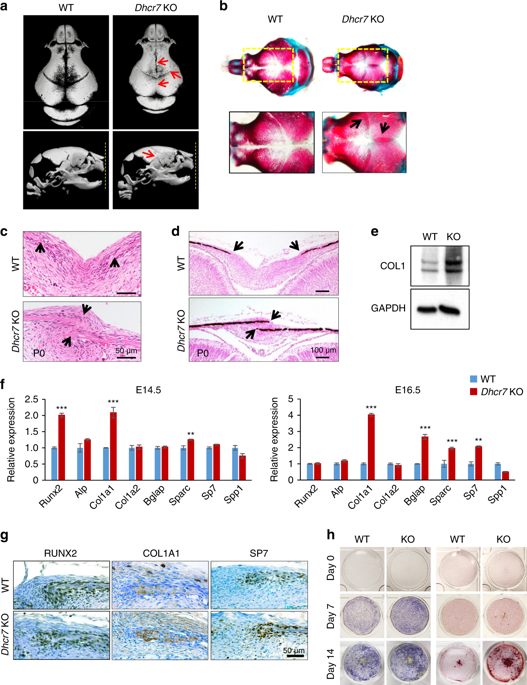Our official English website, www.x-mol.net, welcomes your
feedback! (Note: you will need to create a separate account there.)
Disruption of Dhcr7 and Insig1/2 in cholesterol metabolism causes defects in bone formation and homeostasis through primary cilium formation.
Bone Research ( IF 14.3 ) Pub Date : 2020-01-02 , DOI: 10.1038/s41413-019-0078-3 Akiko Suzuki 1, 2 , Kenichi Ogata 1, 2 , Hiroki Yoshioka 1, 2 , Junbo Shim 1, 2 , Christopher A Wassif 3 , Forbes D Porter 3 , Junichi Iwata 1, 2, 4, 5
Bone Research ( IF 14.3 ) Pub Date : 2020-01-02 , DOI: 10.1038/s41413-019-0078-3 Akiko Suzuki 1, 2 , Kenichi Ogata 1, 2 , Hiroki Yoshioka 1, 2 , Junbo Shim 1, 2 , Christopher A Wassif 3 , Forbes D Porter 3 , Junichi Iwata 1, 2, 4, 5
Affiliation

|
Human linkage studies suggest that craniofacial deformities result from either genetic mutations related to cholesterol metabolism or high-cholesterol maternal diets. However, little is known about the precise roles of intracellular cholesterol metabolism in the development of craniofacial bones, the majority of which are formed through intramembranous ossification. Here, we show that an altered cholesterol metabolic status results in abnormal osteogenesis through dysregulation of primary cilium formation during bone formation. We found that cholesterol metabolic aberrations, induced through disruption of either Dhcr7 (which encodes an enzyme involved in cholesterol synthesis) or Insig1 and Insig2 (which provide a negative feedback mechanism for cholesterol biosynthesis), result in osteoblast differentiation abnormalities. Notably, the primary cilia responsible for sensing extracellular cues were altered in number and length through dysregulated ciliary vesicle fusion in Dhcr7 and Insig1/2 mutant osteoblasts. As a consequence, WNT/β-catenin and hedgehog signaling activities were altered through dysregulated primary cilium formation. Strikingly, the normalization of defective cholesterol metabolism by simvastatin, a drug used in the treatment of cholesterol metabolic aberrations, rescued the abnormalities in both ciliogenesis and osteogenesis in vitro and in vivo. Thus, our results indicate that proper intracellular cholesterol status is crucial for primary cilium formation during skull formation and homeostasis.
中文翻译:

Dhcr7和Insig1 / 2在胆固醇代谢中的破坏会通过初级纤毛形成而导致骨骼形成和体内稳态的缺陷。
人类联系研究表明,颅面畸形是由与胆固醇代谢有关的基因突变或高胆固醇孕妇饮食引起的。然而,人们对细胞内胆固醇代谢在颅面骨发育中的确切作用知之甚少,其中大部分是通过膜内骨化形成的。在这里,我们显示胆固醇代谢状态的改变通过骨骼形成过程中初级纤毛形成的失调导致异常的成骨作用。我们发现,通过破坏Dhcr7(编码参与胆固醇合成的酶)或Insig1和Insig2(提供胆固醇生物合成的负反馈机制)引起的胆固醇代谢异常,会导致成骨细胞分化异常。值得注意的是 在Dhcr7和Insig1 / 2突变型成骨细胞中,由于睫状小泡融合失调,负责感知细胞外信号的初级纤毛的数量和长度发生了变化。结果,WNT /β-catenin和hedgehog信号传导活性通过失调的初级纤毛形成而改变。令人吃惊的是,辛伐他汀(一种用于治疗胆固醇代谢异常的药物)使胆固醇代谢缺陷得以正常化,挽救了体内外的纤毛生成和成骨异常。因此,我们的结果表明,适当的细胞内胆固醇状态对于颅骨形成和体内稳态过程中初级纤毛形成至关重要。结果,WNT /β-catenin和hedgehog信号传导活性通过失调的初级纤毛形成而改变。令人吃惊的是,辛伐他汀(一种用于治疗胆固醇代谢异常的药物)使胆固醇代谢缺陷得以正常化,挽救了体内外的纤毛生成和成骨异常。因此,我们的结果表明适当的细胞内胆固醇状态对于颅骨形成和体内稳态过程中初级纤毛形成至关重要。结果,WNT /β-catenin和hedgehog信号传导活性通过失调的初级纤毛形成而改变。令人吃惊的是,辛伐他汀(一种用于治疗胆固醇代谢异常的药物)使胆固醇代谢缺陷得以正常化,挽救了体内外的纤毛生成和成骨异常。因此,我们的结果表明,适当的细胞内胆固醇状态对于颅骨形成和体内稳态过程中初级纤毛形成至关重要。挽救了体内外纤毛发生和成骨的异常。因此,我们的结果表明,适当的细胞内胆固醇状态对于颅骨形成和体内稳态过程中初级纤毛形成至关重要。挽救了体内外纤毛发生和成骨的异常。因此,我们的结果表明,适当的细胞内胆固醇状态对于颅骨形成和体内稳态过程中初级纤毛形成至关重要。
更新日期:2020-01-02
中文翻译:

Dhcr7和Insig1 / 2在胆固醇代谢中的破坏会通过初级纤毛形成而导致骨骼形成和体内稳态的缺陷。
人类联系研究表明,颅面畸形是由与胆固醇代谢有关的基因突变或高胆固醇孕妇饮食引起的。然而,人们对细胞内胆固醇代谢在颅面骨发育中的确切作用知之甚少,其中大部分是通过膜内骨化形成的。在这里,我们显示胆固醇代谢状态的改变通过骨骼形成过程中初级纤毛形成的失调导致异常的成骨作用。我们发现,通过破坏Dhcr7(编码参与胆固醇合成的酶)或Insig1和Insig2(提供胆固醇生物合成的负反馈机制)引起的胆固醇代谢异常,会导致成骨细胞分化异常。值得注意的是 在Dhcr7和Insig1 / 2突变型成骨细胞中,由于睫状小泡融合失调,负责感知细胞外信号的初级纤毛的数量和长度发生了变化。结果,WNT /β-catenin和hedgehog信号传导活性通过失调的初级纤毛形成而改变。令人吃惊的是,辛伐他汀(一种用于治疗胆固醇代谢异常的药物)使胆固醇代谢缺陷得以正常化,挽救了体内外的纤毛生成和成骨异常。因此,我们的结果表明,适当的细胞内胆固醇状态对于颅骨形成和体内稳态过程中初级纤毛形成至关重要。结果,WNT /β-catenin和hedgehog信号传导活性通过失调的初级纤毛形成而改变。令人吃惊的是,辛伐他汀(一种用于治疗胆固醇代谢异常的药物)使胆固醇代谢缺陷得以正常化,挽救了体内外的纤毛生成和成骨异常。因此,我们的结果表明适当的细胞内胆固醇状态对于颅骨形成和体内稳态过程中初级纤毛形成至关重要。结果,WNT /β-catenin和hedgehog信号传导活性通过失调的初级纤毛形成而改变。令人吃惊的是,辛伐他汀(一种用于治疗胆固醇代谢异常的药物)使胆固醇代谢缺陷得以正常化,挽救了体内外的纤毛生成和成骨异常。因此,我们的结果表明,适当的细胞内胆固醇状态对于颅骨形成和体内稳态过程中初级纤毛形成至关重要。挽救了体内外纤毛发生和成骨的异常。因此,我们的结果表明,适当的细胞内胆固醇状态对于颅骨形成和体内稳态过程中初级纤毛形成至关重要。挽救了体内外纤毛发生和成骨的异常。因此,我们的结果表明,适当的细胞内胆固醇状态对于颅骨形成和体内稳态过程中初级纤毛形成至关重要。











































 京公网安备 11010802027423号
京公网安备 11010802027423号